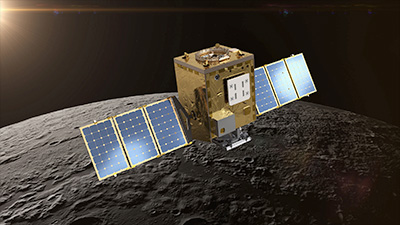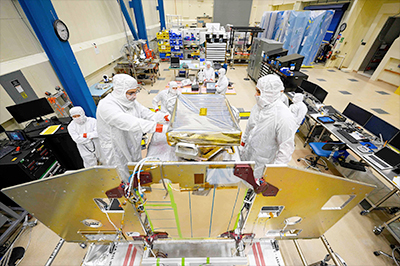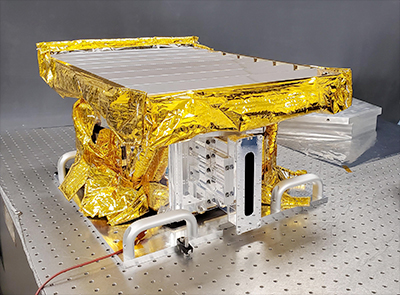|
|

|
|
Author
|
Topic: NASA Lunar Trailblazer to map moon water
|
Robert Pearlman
Editor Posts: 54120
From: Houston, TX
Registered: Nov 1999
|
 posted 12-02-2020 04:13 PM
posted 12-02-2020 04:13 PM
   
NASA release NASA Confirms New SIMPLEx Mission Small Satellite to Blaze Trails Studying Lunar SurfaceA small satellite mission to understand the lunar water cycle – detecting and mapping water on the lunar surface in order to investigate how its form, abundance, and location relate to geology – has received NASA approval to proceed with the next phase of its development. On Nov. 24, the Lunar Trailblazer, a mission selected under NASA's Small Innovative Missions for Planetary Exploration (SIMPLEx) program, passed its Key Decision Point-C (KDP-C) milestone, obtaining agency-level endorsement to begin final design of hardware and build. The milestone also provides the project's official schedule and budget determination.  "Lunar Trailblazer will confirm whether water on the Moon is tightly bound in crystalline rock, as recently suggested by NASA's SOFIA (Stratospheric Observatory for Infrared Astronomy) observations, or loosely bound and mobile as a function of temperature," said Thomas Zurbuchen, associate administrator for science at the agency's headquarters in Washington. "This SIMPLEx mission bolsters our portfolio of targeted science missions designed to test pioneering technologies while reducing overall costs using new streamlined processes." Producing the highest resolution basemaps to locate ice or water trapped in rock at the Moon's surface, Lunar Trailblazer will help support NASA's Artemis program, which includes establishing a sustainable presence on the Moon by the end of the decade and preparing for crewed missions to Mars. "We're excited to help answer big planetary science questions with a small satellite by making the new maps of water on the Moon," said Bethany Ehlmann, the mission's principal investigator, of Caltech. "Given the importance of water on the Moon for future robotic and human missions, Lunar Trailblazer will provide critical basemaps to guide future exploration." Peering into the Moon's permanently shadowed regions, Lunar Trailblazer will detect signatures of ice in reflected light, and it will pinpoint the locations of micro-cold traps less than a football field in size. Collecting measurements at multiple times of day over sunlit regions, the mission will help scientists understand whether the water signature on the illuminated surface changes as the lunar surface temperature changes by hundreds of degrees over the course of a lunar day. "Lunar Trailblazer will vastly advance our understanding of water cycles on airless bodies like the Moon," said Lori Glaze, director of NASA's Planetary Science Division at the agency's headquarters in Washington. "By measuring both direct light and low levels of terrain-scattered light, Lunar Trailblazer will generate comprehensive maps of surface water ice, even in the Moon's darkest regions." Selected in 2019, Lunar Trailblazer is the second mission from the current round of programs to receive confirmation and plans to deliver its flight system in October 2022, with a currently planned February 2025 launch. The Janus mission received its confirmation in early September 2020 and will investigate the formation and evolution of small, deep-space "rubble pile" asteroids. The Escape and Plasma Acceleration and Dynamics Explorers (EscaPADE) mission is still in formulation, with its KDP-C planned for summer of 2021. "Lunar Trailblazer has a talented, multi-institutional team whose collective effort resulted in a successful formulation phase and confirmation review," said Calina Seybold, Lunar Trailblazer Project manager, at NASA's Jet Propulsion Laboratory. "I am thrilled that the team has earned the privilege of continuing to our final design and fabrication phase." |
Robert Pearlman
Editor Posts: 54120
From: Houston, TX
Registered: Nov 1999
|
 posted 08-22-2022 03:44 PM
posted 08-22-2022 03:44 PM
   
NASA release Lunar Trailblazer to Launch 2023, Subject to Cost ReviewNASA's Lunar Trailblazer mission is now scheduled to launch in mid-2023, around two years ahead of its original timeline. The decision means the spacecraft, targeted for completion by spring 2023, will skip a previously planned two-year storage period and move straight to launch. Lunar Trailblazer, a mission selected under NASA's Small Innovative Missions for Planetary Exploration (SIMPLEx) program, is a small satellite designed to provide an understanding of the form, abundance, and distribution of water on the Moon, as well as the lunar water cycle. As a SIMPLEx mission, the spacecraft launches via "rideshare," a secondary payload on a larger mission's rocket. Lunar Trailblazer was originally manifested as a rideshare on the Interstellar Mapping and Acceleration Probe (IMAP), launching in 2025. As announced in June, however, NASA amended the mission agreement, and NASA's Jet Propulsion Laboratory (JPL) in Southern California, which manages Lunar Trailblazer for the principal investigator at Caltech, signed a contract in early August for it to fly as a secondary payload on the second lunar lander mission by Intuitive Machines, called IM-2. That IM-2 lunar delivery, carrying NASA's PRIME-1 subsurface ice drill, is scheduled to launch in mid-2023. Separately, a continuation/termination review will be held later this fall to assess issues that led to cost overruns reported by the Lunar Trailblazer project. In June, mission spacecraft subcontractor Lockheed Martin provided notice of recent cost overruns. SIMPLEx mission proposals were cost capped at $55M. NASA's SIMPLEx program provides opportunities for low-cost, risk-tolerant science missions that are selected with the understanding that they can be responsive to requirements for flexibility. These lower cost missions serve as an ideal platform for technical and architecture innovation, contributing to NASA's science research and technology development objectives. |
Robert Pearlman
Editor Posts: 54120
From: Houston, TX
Registered: Nov 1999
|
 posted 11-09-2022 04:13 PM
posted 11-09-2022 04:13 PM
   
NASA release NASA Continues Lunar Trailblazer MissionNASA announced Wednesday (Nov. 9) that its Lunar Trailblazer mission is approved to go forward, targeting a launch in mid-2023. NASA confirmed Lunar Trailblazer in 2020 as part of the agency's Small Innovative Missions for Planetary Exploration (SIMPLEx) program to provide an understanding of the form, abundance, and distribution of water on the Moon, as well as the lunar water cycle. The agency evaluated the Lunar Trailblazer mission after cost overruns were reported by the project, which is led by Principal Investigator Dr. Bethany Ehlmann of the California Institute of Technology (Caltech) in Pasadena and managed by NASA's Jet Propulsion Laboratory in Southern California. The overruns were communicated by Lockheed Martin, the flight system integrator. SIMPLEx projects have a higher risk posture and lighter oversight and management requirements to maintain a lower overall mission cost; however, the integrator found that mission success required additional engineering and design efforts that exceeded the original estimate and resulted in an overrun. Since that notification, the project partners have worked to fully understand the sources and overall impact of the cost overrun, and they have replanned the remaining work and costs to deliver the mission for a total increase of $8 million. The mission will also implement changes to reduce programmatic risks and seek out more operational efficiencies going forward. Mission proposals for SIMPLEx program were cost capped at $55 million. The updated mission total of $72M includes previously agreed-to changes to the mission's implementation, including spacecraft vendor, launch provider and launch date, among others. The team continues to work on spacecraft assembly, having just begun flight system integration at Lockheed Martin. The spacecraft's two science instruments – the High-resolution Volatiles and Minerals Moon Mapper from JPL, and the Lunar Thermal Mapper from the University of Oxford, funded by the United Kingdom Space Agency – are scheduled to be delivered before the end of the year. The next milestone is an operational readiness review of tools and procedures for mission operations. Mission operations will be conducted from the Caltech campus. The spacecraft will arrive at the Moon and begin its science mapping approximately six months after its mid-2023 launch. The spacecraft is scheduled to launch as a secondary payload on the second lunar lander mission by Intuitive Machines, called IM-2. |
Robert Pearlman
Editor Posts: 54120
From: Houston, TX
Registered: Nov 1999
|
 posted 12-22-2022 07:06 PM
posted 12-22-2022 07:06 PM
   
NASA release Moon Water Imager Integrated With NASA's Lunar TrailblazerJPL's cutting-edge instrument, which will provide insights into the lunar water cycle and composition of the moon's surface, has been incorporated into the small satellite. Lunar Trailblazer, NASA's mission to understand lunar water and the moon's water cycle led by Caltech in Pasadena, California, is one step closer to launching next year. Earlier this month, the agency's Jet Propulsion Laboratory in Southern California delivered a key science instrument to Lockheed Martin Space in Colorado, and the teams integrated it with the small satellite, or SmallSat.  Above: Engineers work on the High-resolution Volatiles and Minerals Moon Mapper (HVM3) for NASA's Lunar Trailblazer spacecraft in a clean room at Lockheed Martin Space in Littleton, Colorado, shortly after the instrument was delivered there in December 2022. (Lockheed Martin) The instrument, called the High-resolution Volatiles and Minerals Moon Mapper (HVM3), is one of two on Lunar Trailblazer. HVM3 will detect and map water on the moon's surface to determine its abundance, location, form, and how it changes over time. This information will provide data on the lunar water cycle and help inform future human missions as to where supplies of water may be found and extracted as a resource. "The calibration and integration of HVM3 is a major milestone, because after three years of hard work the team delivered our key science instrument. This is a very exciting time," said Walton Williamson, systems engineer at JPL and the HVM3 instrument manager. The other instrument, the Lunar Thermal Mapper infrared multispectral imager, is being developed by the University of Oxford in the U.K. and is scheduled for delivery and integration in early 2023. Exquisite Sensitivity Selected under NASA's Small Innovative Missions for Planetary Exploration (SIMPLEx) program in 2019, Lunar Trailblazer measures only 11.5 feet (3.5 meters) wide with its solar panels fully deployed, but this a compact spacecraft with far-reaching goals.  Above: The HVM3 instrument sits in a JPL clean room in early December 2022. The instrument was built at JPL then shipped to Lockheed Martin Space in Colorado to be integrated with NASA's Lunar Trailblazer spacecraft (NASA/JPL-Caltech) While past observations have confirmed that the moon has water on its surface, little is known about its distribution or form. HVM3, an imaging spectrometer, will fill this knowledge gap by mapping the spectral fingerprints – or wavelengths of reflected sunlight – of the different forms of water over the lunar landscape to make high-resolution maps. For instance, water molecules could be locked inside lunar rock and regolith – broken rock and dust – and they may settle for short periods as frost in cold shadows. As the Sun moves across the sky during the lunar day, the shadows move, too, cycling these water molecules into the moon's exosphere and transporting them to other cold places where they can settle once more as a frost. The most likely locations to hold water ice in significant quantities are permanently shadowed craters at the lunar poles, which are key targets for science and exploration. To differentiate between these different forms of water, how they move, and where they are located, HVM3 has two key features that set it apart from other spectrometers. The first is its ability to detect a wide range of infrared wavelengths that are readily absorbed by different forms of water. The second is its sensitivity to those wavelengths: HVM3 is designed to be sensitive to low illumination levels, which will be critical to revealing water that may be found in the moon's darkest craters. "Measuring the permanently shadowed regions of the lunar surface will be the most challenging part of the mission," said David R. Thompson, senior research scientist at JPL and HVM3 instrument scientist. "To observe any ice on the floors of those craters that haven't seen sunlight for eons, we'll be using light scattered off neighboring solar-illuminated crater walls." Thompson likens this to a bank shot in basketball, when a player makes a shot that bounces from the backboard into the basket. Solar photons – the quantum particles of light – bounce, or scatter, off the sunlit slopes of the crater and are redirected into the permanently shadowed crater bottoms. This light can be over a thousand times dimmer than direct solar illumination, requiring exquisite instrument sensitivity. Where HVM3 will look for water, Lunar Thermal Mapper will detail the temperature properties of the moon's surface. Together, they will provide scientists with a deeper knowledge of how surface temperature affects the distribution of water on the moon. "This mission was tailor-made to unlock the persisting mystery of the moon's water by mapping its distribution while also helping us understand if it's locked within lunar material or covering the surface as ice in cold spots," said Bethany Ehlmann, the Lunar Trailblazer principal investigator at Caltech. "I am immensely proud of the Trailblazer team for completing this important milestone of instrument delivery. Now we are focusing on the next phases as we approach launch." |
Robert Pearlman
Editor Posts: 54120
From: Houston, TX
Registered: Nov 1999
|
 posted 02-27-2025 09:18 PM
posted 02-27-2025 09:18 PM
   
NASA release NASA Working to Reestablish Communications With Lunar TrailblazerFollowing the successful deployment of NASA's Lunar Trailblazer from a SpaceX Falcon 9 rocket on Feb. 26, mission operators at Caltech's IPAC [Infrared Processing and Analysis Center] in Pasadena, California, established communications with the small satellite at 5:13 p.m. PST, as expected. The team subsequently received engineering data, or telemetry, indicating intermittent power system issues. They lost communication with the spacecraft Thursday morning (Feb. 27) at about 4:30 a.m. PST. Several hours later, the spacecraft turned on its transmitter, and the team now is working with NASA ground stations to reestablish telemetry and commanding to better assess the power system issues and develop potential solutions. |
Robert Pearlman
Editor Posts: 54120
From: Houston, TX
Registered: Nov 1999
|
 posted 03-04-2025 07:35 PM
posted 03-04-2025 07:35 PM
   
NASA release NASA Continuing Efforts to Contact, Command Lunar TrailblazerThe mission operations team for NASA's Lunar Trailblazer at Caltech's IPAC is continuing efforts to re-establish communications with the small satellite. Based on telemetry before the loss of signal last week and ground-based radar data collected March 2, the team believes the spacecraft is spinning slowly in a low-power state. They will continue to monitor for signals should the spacecraft orientation change to where the solar panels receive more sunlight, increasing their output to support higher-power operations and communication. The team has been receiving constant coverage from NASA's Deep Space Network and working with ground-based observatories to better understand Lunar Trailblazer's orientation. The spacecraft issues have precluded the execution of post-launch trajectory correction maneuvers (TCMs). These small thruster operations would have adjusted the spacecraft's flight path and — together with future TCMs — put it into its planned science orbit around the Moon. The team is now working to define alternative TCM strategies that could be used after reacquiring communications and establishing normal spacecraft functionality. These alternative TCM strategies may be able to place Lunar Trailblazer in lunar orbit and allow it to complete some of its science objectives. "The Lunar Trailblazer team has been working around the clock to re-establish communications with the spacecraft," said Nicky Fox, associate administrator of the Science Mission Directorate at NASA Headquarters in Washington. "NASA sends up high-risk, high-reward missions like Lunar Trailblazer to do incredible science at a lower cost, and the team truly encapsulates the NASA innovative spirit — if anyone can bring Lunar Trailblazer back, it is them." | |
Contact Us | The Source for Space History & Artifacts
Copyright 1999-2025 collectSPACE. All rights reserved.

Ultimate Bulletin Board 5.47a
|
|

|
 advertisement advertisement

|














